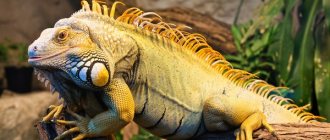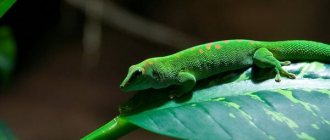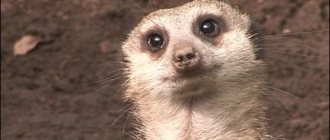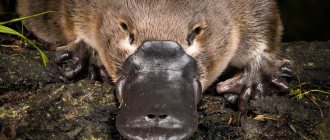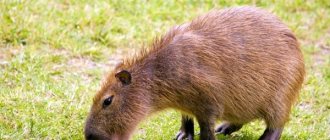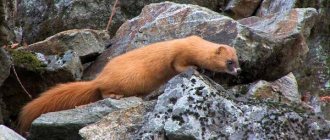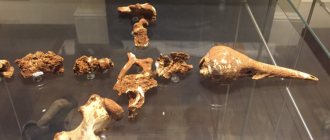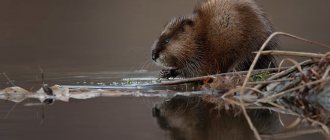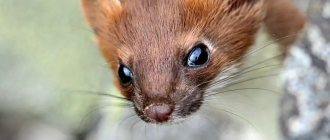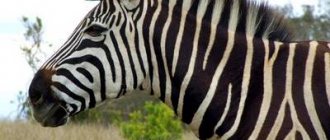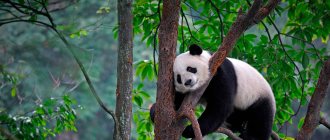Monitor lizards are a large genus of lizards from the order of scaly reptiles. The first ancestors of these reptiles appeared on the planet in the Eocene era (about 500 million years ago). South Asia is considered the historical homeland of monitor lizards. Later, reptiles spread to other territories within the tropical climate zone.
Most representatives of the genus have stably replenished populations. The only exceptions are large reptiles. Currently, three species of giant monitor lizards are listed as vulnerable species in the International Red Book. The main reasons for the decline in the number of pangolins are: shrinking habitat, changing climatic conditions and uncontrolled destruction by humans for the sake of obtaining skins.
Characteristics and description
In the wild, monitor lizards live alone and can gather in small groups only during the breeding season or around large carrion. They do not change their habitat throughout their lives, finding food in the area around their shelter, but their hunting grounds do not have clear boundaries.
Monitor lizards lead a diurnal lifestyle: they leave their shelters at dawn and, after the air has warmed up enough, go hunting. Reptiles may seem clumsy and slow, but this impression is wrong. The maximum speed that they are capable of developing while hunting reaches 20 km/h. At the same time, many species are able to pursue prey in trees and in water.
Monitor lizards, belonging to the suborder of lizards, differ from real lizards in some features of their body structure:
- they are not able to shed their tail;
- the main difference of the skeleton is the completely ossified skull and movable jaw articulation, which allows swallowing large prey;
- the teeth are conical and pointed at the edges;
- Unlike other reptiles, monitor lizards have a four-chambered heart and two circulation circuits.
What does it look like
The appearance of monitor lizards has the following features:
- a long elongated body located parallel to the ground;
- limbs are semi-bent, with well-developed fingers, at the ends of which there are long curved claws;
- the tail is strong, its length usually exceeds the length of the body;
- the head is small on an elongated neck;
- the tongue is long, with a forked end;
- The eyes are large, with a round pupil, and the eyelids are mobile.
How many years do they live
The lifespan of monitor lizards depends on the variety. Larger species live longer than small lizards. Thus, giant reptiles that did not die from attacks by natural enemies in the first 3-4 years often live to be 40-50 years old. For small species, the record figure is 15-20 years.
Attitude towards tourists
Monitor lizards often live on the territory of hotels and campsites. They do not show aggression towards people. They come to eat: they dig through the garbage, absorb meat and fish waste, and other scraps. Varan Gulda is not so useless anymore. It repels snakes, so tourists and locals are happy to be in this neighborhood.
You should not try to make friends with a monitor lizard, much less stroke it. He may get scared and start to defend himself. Reptiles bite painfully. The skin around the wound swells, is very painful and bleeds. The sand monitor's saliva contains toxic substances.
Types of monitor lizards with photos and names
The genus of monitor lizards is the only one in the monitor lizard family. The classification identifies about 80 existing species, grouped into 9 subfamilies. Let's take a closer look at some of the varieties.
Komodo dragon
Varanus komodoensis
Also known as the Komodo dragon or Indonesian monitor lizard. Found on several islands in Indonesia. The most numerous populations live on the island. Komodo and Fr. Flores.
This is the largest monitor lizard in the world, the length of which can reach 3 m. There are known cases of attacks by these giant reptiles on people.
For a long time it was believed that when a Komodo dragon bites, a large number of pathogenic microbes enter the wound from its mouth, as a result of which the bitten animal soon dies from infection. Recent studies have shown that the reptile is capable of secreting poison that affects blood clotting. The use of a poisonous substance by reptiles allows them to successfully hunt prey of equal size.
Perenty
Varanus giganteus
The scientific classification uses the name Australian giant monitor lizard. One of the largest lizards among the representatives of its family. Found in western and central Australia.
The species is characterized by a spotted color: on the brown body there is a large number of yellowish-pink spots bordered by a thin black stripe.
Salvador monitor lizard
Varanus salvadorii
Endemic to the island of New Guinea. Also known as the crocodile monitor. The lizard has a dark green color, the body and tail are covered with light yellow spots and stripes. You can also recognize it by its rounded, blunt muzzle.
The species belongs to the arboreal reptiles. The usual habitat is mangrove swamps and dense forests.
Dark monitor lizard
Varanus glebopalma
A medium-sized reptile that lives in northern Australia. The main feature of the species is its nocturnal lifestyle. You can meet lizards in rocky areas. They use spaces between stones, cracks and crevices as shelters.
To facilitate movement on rocks, the foot pads of dark monitor lizards are covered with scales.
McRae's monitor
Varanus macraei
The species was discovered relatively recently. The McRae's blue monitor lives on the island of Batanta in Indonesia. Spends most of its time in trees in dense thickets of tropical forests. You can recognize the variety by its characteristic color, which combines black and blue.
Nile monitor
Varanus niloticus
The largest representative of the family living in Africa. The species is distributed throughout the continent with the exception of deserts. The animal is of commercial importance: the meat is eaten, and the tanned skins are exported mainly to European countries.
The Nile monitor lizard is quite aggressive in nature and can pose a danger to humans.
Gray monitor lizard
Varanus griseus
Some sources mention it as desert or Caspian. Within the species, there are three varieties, of which the most common is the Central Asian gray monitor lizard.
Reptiles live in burrows, from which they emerge only while hunting, after warming up in the sun not far from the entrance. The color of gray monitor lizards is dominated by sand, gray, and light brown shades.
Eating habits
The giant Indonesian monitor lizard is a carnivore known for its insatiable appetite . He was often seen engaging in cannibalism. Adult Komodo dragons are the biggest threat to juveniles. Up to 10% of their diet consists of immature relatives.
However, the Komodo dragon is not lazy - it is capable of tracking down prey 10 times larger than itself. It will readily pursue large mammals (water buffalo, wild boar, horses, deer).
When monitor lizards find small prey, they attack it in the throat area, and they first try to knock down large prey. This once again proves their enormous - dragon - power. A strong tail is a good “helper” when attacking a large animal. This is a deadly weapon with a force of 2 tons.
The monitor lizard's favorite prey is the maned sambar. These deer are fast and cautious creatures that can only be caught by a skilled predator . Komodo dragons lie quietly along the paths and wait for the deer to pass close enough to catch him. There won't be much left of a captured animal - the Komodo dragon will even swallow hooves, bones and skin.
Dimensions
Among the numerous varieties of monitor lizards, there are individuals that differ greatly from each other in appearance and size. Comparative characteristics of some representatives of monitor lizards are given below.
| Type name | Length, cm | Weight, kg |
| Striped | 250 | 30 |
| Blacktooth | 200 | 25 |
| Motley | 190 | 8,8 |
| Bengal | 175 | 7,2 |
| Black-throated | 150 | 5,5 |
| Indian | 100 | 3 |
| Short-tailed | 28 | 0,3 |
| Dwarf | 25 | 0,2 |
The table shows the average weight and body length of monitor lizards, since living conditions and the availability of sufficient food supply have a significant impact on the size of individuals.
Mating games of titans
The monitor lizard who defeats his opponent can choose a girlfriend with whom he will have children. The pair will build a nest, the female will guard the eggs for about eight months, which may be encroached upon by small nocturnal predators. By the way, relatives are also not averse to enjoying such a delicacy. But as soon as the babies are born, the mother will leave them. They will have to survive on their own, relying only on the ability to camouflage and run.
Monitor lizards do not form permanent pairs. The next mating season will begin from scratch - that is, with new battles in which more than one dragon will die.
Where do they live?
The habitat of most modern species of monitor lizards is Australia, as well as the islands and archipelagos of Oceania. Reptiles live on the Arabian Peninsula, Central and South Asia.
Monitor lizards are also common throughout almost the entire African continent, but are not represented in the Madagascar fauna. It was this fact that served as the basis for the theory of the Asian origin of the family.
Where live
The natural habitat of monitor lizards is the tropics. The exception is the desert monitor lizard, the northern part of its range is in a temperate climate.
All types of monitor lizards are divided into three groups:
- desert ones live in arid regions with sparse bushes, savannas and woodlands;
- aquatic animals, which resemble amphibians in their lifestyle, spend most of their time in water, so they settle near ponds and swamps;
- arboreals live in dense tropical forests, climbing tree branches.
Monitor lizards are important in habitat ecosystems: they control rodent and insect populations and provide food for many species of birds and mammals.
Nutrition
The sand monitor is an active predator. If there is no opportunity for hunting, he agrees to eat carrion. The main share of such “easy” prey consists of kangaroos hit by cars and lying on the roads.
The reptile has an excellent sense of smell; it can sense prey from a kilometer away. The tongue acts as an olfactory organ. The monitor lizard can smell prey that is underground. To dig it out, it uses its muzzle and claws.
The basis of the diet of the sand monitor consists of:
- reptiles;
- birds;
- small mammals;
- amphibians;
- insects;
- crustaceans;
- eggs.
There is an opinion that sand monitor lizards practice cannibalism, but there are no facts confirming this. But they eat dead relatives.
What do they eat?
Monitor lizards are predatory animals. Usually they wait for the victim in ambush and attack it, making a swift rush.
The diet of reptiles is based on insects, invertebrates, mollusks, fish, turtles, rodents and other small mammals. Monitor lizards have a well-developed sense of smell and easily find masonry left by crocodiles, snakes and turtles. They swallow small prey whole, and tear off pieces from large animals.
Monitor lizards are cannibals. They quite often enter into fights with their relatives and eat their less fortunate rivals. Females can only eat the eggs that have hatched.
SNAIL
Lifestyle
Lifestyle of a monitor lizard
Despite its apparent clumsiness, the animal can run quickly, accelerating up to 25 km/h. In addition, these lizards are excellent swimmers.
During the day they walk around the territory in search of food, and at night they climb into holes.
The real loners are monitor lizards. They do not like their relatives, and when they meet on a narrow path, they start a fight.
How do they reproduce?
The breeding season of monitor lizards coincides with the beginning of the rainy season. Different species can have from 10 to 60-70 eggs in one clutch. Before laying eggs, the female digs a hole in wet sand or looks for a suitable place: an abandoned hole, hollow or termite mound.
The incubation period lasts 9-10 months. Females do not return to lay eggs and do not take care of their offspring. The cubs that are born are completely independent. At first, they are forced to hide in trees or in crevices between stones, so as not to become prey to natural enemies and larger relatives.
Some species of monitor lizards have the ability to parthenogenesis: females do not need prior mating with males to lay fertilized eggs.
FROG
Cubs development
In September, females lay eggs in nests they have dug. This is also where the intelligence of the Komodo dragon comes into play. Females often dig so-called fake nests , perhaps to confuse wild boars who like to feast on goat eggs. The female lays about 20 eggs the size of a grapefruit (about 12 cm in diameter). The young hatch after about 7-8 months. During this time, the mother regularly visits her nest to protect the eggs from other animals.
At birth, a young monitor lizard is approximately 30 cm long. After leaving the nest, it must take care of itself. The adults pose the greatest threat to the young, so they spend their early years in the trees, feeding on small mammals, lizards, insects and bird eggs. After about 6 years, the Komodo dragon grows up to two meters in length.
It has been discovered that female Indonesian giant monitor lizards can reproduce through parthenogenesis (immaculate conception) . This means that babies are formed only from the egg, without the “help” of sperm. This is a rare occurrence among reptiles. However, this is not a very positive phenomenon, since it ultimately reduces the genetic diversity among monitor lizards.
- Average clutch size: 18-20 eggs
- Incubation period: 7-8 months
Captivity
Monitor lizards are one of the few reptiles suitable for home keeping. When purchasing and arranging a terrarium, it is necessary to take into account the size of the animal and whether it belongs to a steppe, arboreal or aquatic species.
Thus, the length of the terrarium should exceed the length of the reptile by at least one and a half times, while for desert species it is worth purchasing horizontal models, for aquatic species - cubic, and for arboreal species - vertical. Driftwood and stones are placed inside, and sand or fine gravel is used as soil.
Under natural conditions, most species live in natural areas with a warm climate, so the temperature in the terrarium should be maintained at 28-30 degrees.
Young reptiles are fed daily, from 6-7 months they begin to give food every other day, and at the age of 1.5 years the number of feedings is reduced to 2 times a week.
The most suitable for keeping in captivity are the spiny-tailed, blue-tailed, emerald, Timorese, Cape and other species of small monitor lizards.
GIRAFFE
Story
Giant monitor lizards were first discovered on Komodo Island in the early 20th century. Since then, scientists have continued to study the species.
It has been established that the history of the development and evolution of monitor lizards is connected with Australia. The species diverged from its historical ancestor approximately 40 million years ago, then emigrated to the distant mainland and nearby islands.
Later the population shifted to the islands of Indonesia. This may be due to natural phenomena or a decline in the populations of species of food interest to monitor lizards. In any case, the fauna of Australia only benefited from such a relocation - many species were literally saved from extinction. But the Indonesian ones were unlucky: many scientists associate their extinction with predators of the Varanus genus.
Modernity has successfully mastered new territories and feels great.
Interesting Facts
- Komodo dragons have powerful immunity against many bacteria. In 2022, a protein compound with antibacterial properties was isolated from the blood of an animal. A substance of similar composition, synthesized in the laboratory, turned out to be effective against many drug-resistant bacteria and fungi.
- Large monitor lizards feed on carrion. There are known cases when large lizards dug up corpses in cemeteries and ate them. In this regard, in the habitats of giant reptiles, areas with dense soil are used for burying the dead, and heavy stones or concrete slabs are laid on top of the graves.
- In Central and South America, as well as on the Galapagos Islands, teiids, similar to monitor lizards in appearance and behavior, live. The American monitor lizard family (tegus, caiman lizards, ameivas) is not related to the South Asian and Australian species. Their appearance is a consequence of convergent evolution.
- The skin of giant monitor lizards is quite durable and suitable for processing. Shoes, bags, and belts are made from it. In some countries in Asia and Oceania, lizard meat and eggs are used for food.
Are Komodo dragons poisonous?
Komodo dragon saliva contains potentially harmful bacteria. These bacteria are thought to reduce the resistance of prey, especially if it is too large. One study found 23 species of bacteria in the saliva of wild dragons, but only 10 species of bacteria in the saliva of captive monitor lizards. Some research suggests that Komodo dragons may also be poisonous due to certain properties of components in their saliva.
Origin story
People started talking about Komodo dragons at the time when, at the beginning of the 20th century, on the island. Java (Holland) received a telegram from the manager that in the Lesser Sunda Archipelago there live huge, either dragons or lizards, which scientific researchers have not yet heard of. Van Stein from Flores wrote about this, that near the island of Flores and on Komodo there lives a “land crocodile” still incomprehensible to science.
Local residents told Van Stein that monsters inhabit the entire island, they are very ferocious, and they are feared. Such monsters can reach 7 meters in length, but Komodo dragons that are four meters long are more common. Scientists from the Zoological Museum of Java decided to ask Van Stein to gather people from the island and get a lizard that European science did not yet know about.
And the expedition managed to catch a Komodo dragon, but it was only 220 cm tall. Therefore, the searchers decided, at all costs, to get the giant reptiles. And they eventually managed to bring 4 large Komodo crocodiles, each three meters, to the zoological museum.
Later, in 1912, everyone already knew about the existence of the giant reptile from the published almanac, in which a photograph of a huge lizard was printed with the caption “Komodo dragon.” After this article, Komodo dragons also began to be found in the vicinity of Indonesia, on several islands. However, only after the Sultan’s archives were studied in detail, it became known that giant foot-and-mouth disease was known back in 1840.
It so happened that in 1914, when the world war began, a group of scientists had to temporarily close the research and capture of Komodo dragons. However, 12 years later they started talking about Komodo dragons in America and called them “dragon comodo” in their native language.
